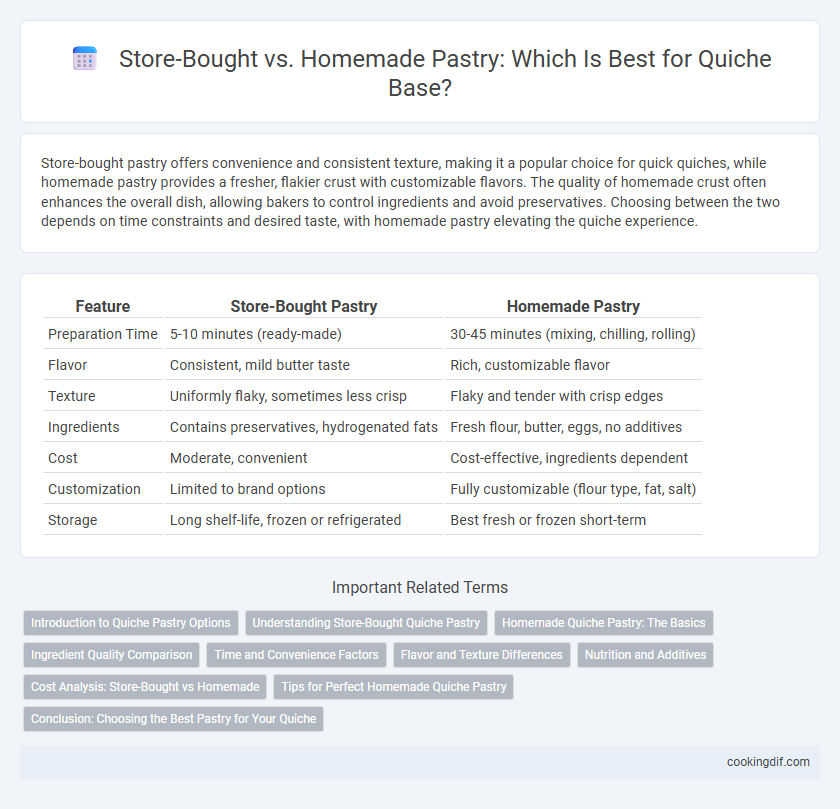Store-bought pastry offers convenience and consistent texture, making it a popular choice for quick quiches, while homemade pastry provides a fresher, flakier crust with customizable flavors. The quality of homemade crust often enhances the overall dish, allowing bakers to control ingredients and avoid preservatives. Choosing between the two depends on time constraints and desired taste, with homemade pastry elevating the quiche experience.
Table of Comparison
| Feature | Store-Bought Pastry | Homemade Pastry |
|---|---|---|
| Preparation Time | 5-10 minutes (ready-made) | 30-45 minutes (mixing, chilling, rolling) |
| Flavor | Consistent, mild butter taste | Rich, customizable flavor |
| Texture | Uniformly flaky, sometimes less crisp | Flaky and tender with crisp edges |
| Ingredients | Contains preservatives, hydrogenated fats | Fresh flour, butter, eggs, no additives |
| Cost | Moderate, convenient | Cost-effective, ingredients dependent |
| Customization | Limited to brand options | Fully customizable (flour type, fat, salt) |
| Storage | Long shelf-life, frozen or refrigerated | Best fresh or frozen short-term |
Introduction to Quiche Pastry Options
Store-bought quiche pastry offers convenience and consistent texture, ideal for quick meal preparation and busy schedules. Homemade pastry allows control over ingredients and thickness, resulting in a flaky, buttery crust tailored to personal taste preferences. Choosing between store-bought and homemade bases affects the quiche's overall flavor profile and texture experience.
Understanding Store-Bought Quiche Pastry
Store-bought quiche pastry offers consistent texture and convenience with a flaky crust made from refined flour and vegetable shortening or butter, ensuring quick preparation without compromising taste. It often contains preservatives to extend shelf life, but may lack the rich, buttery flavor and crumbly texture achievable with homemade dough made from fresh ingredients like high-quality butter and unbleached flour. Choosing store-bought pastry suits busy cooks seeking reliable results, while homemade pastry allows for customization in thickness, flavor, and ingredient control for a superior quiche base.
Homemade Quiche Pastry: The Basics
Homemade quiche pastry offers superior texture and flavor compared to store-bought options, made from simple ingredients like flour, butter, cold water, and a pinch of salt. The key to perfect homemade pastry lies in keeping the butter cold to create a flaky, tender crust that holds fillings without becoming soggy. Mastering basic techniques such as proper dough chilling and gentle handling ensures a crisp, golden base that enhances the overall quiche experience.
Ingredient Quality Comparison
Store-bought pastry often contains preservatives and stabilizers to extend shelf life, which can compromise the freshness and texture of the quiche crust. Homemade pastry allows control over ingredient quality, typically using fresh butter, sifted flour, and minimal additives, resulting in a flakier, richer base with superior flavor. Comparing ingredient profiles highlights the higher proportion of whole ingredients and absence of artificial components in homemade pastry, enhancing overall quiche quality.
Time and Convenience Factors
Store-bought pastry saves significant preparation time and offers unmatched convenience for quiche bases, making it ideal for quick meals or busy schedules. Homemade pastry provides control over ingredients and texture but requires precise mixing, chilling, and rolling, which can be time-consuming. Choosing between the two depends on balancing the need for speed with the desire for culinary customization.
Flavor and Texture Differences
Store-bought pastry offers convenience but often lacks the rich, buttery flavor and flaky texture of homemade pastry. Homemade pastry typically provides a tender, melt-in-the-mouth crust with a pronounced buttery taste due to fresh ingredients and careful preparation. The contrast in texture and flavor between the two can significantly impact the overall enjoyment of a quiche.
Nutrition and Additives
Homemade pastry for quiche base offers better control over ingredients, typically reducing unhealthy fats and additives compared to store-bought options. Store-bought pastry often contains preservatives, artificial flavors, and higher sodium levels that can impact overall nutrition. Choosing homemade pastry allows for fresher ingredients and a healthier nutritional profile by minimizing processed additives.
Cost Analysis: Store-Bought vs Homemade
Store-bought pastry typically costs between $3 to $6 per pie crust, offering convenience but potentially higher cumulative expense for frequent bakers. Homemade pastry ingredients--flour, butter, water, and salt--average around $1 to $2 per crust, significantly reducing per-use cost while allowing customization. Factoring in time and skill, homemade pastry proves cost-effective for regular quiche enthusiasts, whereas store-bought suits occasional or time-constrained baking needs.
Tips for Perfect Homemade Quiche Pastry
Creating a perfect homemade quiche pastry requires using cold butter and ice water to achieve a flaky texture, ensuring the dough is not overworked to prevent toughness. Rest the dough in the refrigerator for at least 30 minutes to relax the gluten and make rolling easier. Blind baking the crust before adding the filling prevents sogginess and maintains a crisp, golden base for the quiche.
Conclusion: Choosing the Best Pastry for Your Quiche
Store-bought pastry offers convenience and consistent quality, making it ideal for quick quiche preparation. Homemade pastry provides a customizable texture and flavor, allowing for richer, flakier crusts that enhance the overall dish. Selecting the best pastry depends on your time, skill level, and desired taste, balancing ease with culinary precision.
Store-bought vs homemade pastry for base Infographic

 cookingdif.com
cookingdif.com